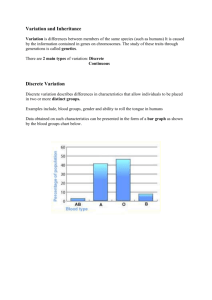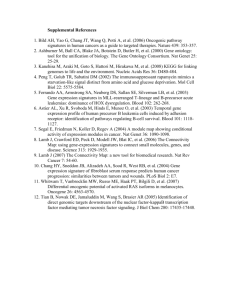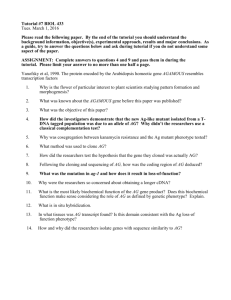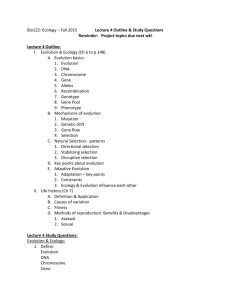Locus - BioMed Central
advertisement
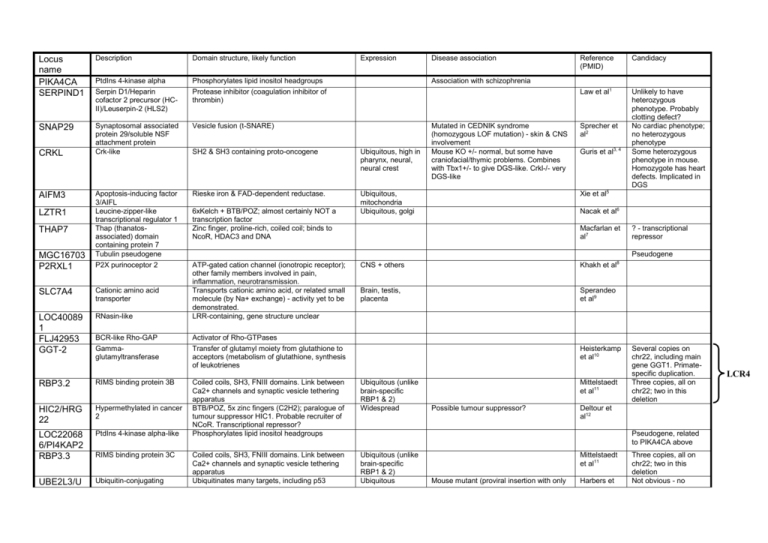
Locus name PIKA4CA SERPIND1 Description Domain structure, likely function PtdIns 4-kinase alpha Serpin D1/Heparin cofactor 2 precursor (HCII)/Leuserpin-2 (HLS2) Phosphorylates lipid inositol headgroups Protease inhibitor (coagulation inhibitor of thrombin) Association with schizophrenia SNAP29 Synaptosomal associated protein 29/soluble NSF attachment protein Crk-like Vesicle fusion (t-SNARE) SH2 & SH3 containing proto-oncogene Ubiquitous, high in pharynx, neural, neural crest Mutated in CEDNIK syndrome (homozygous LOF mutation) - skin & CNS involvement Mouse KO +/- normal, but some have craniofacial/thymic problems. Combines with Tbx1+/- to give DGS-like. Crkl-/- very DGS-like Apoptosis-inducing factor 3/AIFL Leucine-zipper-like transcriptional regulator 1 Thap (thanatosassociated) domain containing protein 7 Tubulin pseudogene P2X purinoceptor 2 Rieske iron & FAD-dependent reductase. Ubiquitous, mitochondria Ubiquitous, golgi CRKL AIFM3 LZTR1 THAP7 MGC16703 P2RXL1 6xKelch + BTB/POZ; almost certainly NOT a transcription factor Zinc finger, proline-rich, coiled coil; binds to NcoR, HDAC3 and DNA Expression Reference (PMID) Candidacy Law et al1 Unlikely to have heterozygous phenotype. Probably clotting defect? No cardiac phenotype; no heterozygous phenotype Some heterozygous phenotype in mouse. Homozygote has heart defects. Implicated in DGS Sprecher et al2 Guris et al3, 4 Xie et al5 Nacak et al6 Macfarlan et al7 ? - transcriptional repressor Pseudogene ATP-gated cation channel (ionotropic receptor); other family members involved in pain, inflammation, neurotransmission. Transports cationic amino acid, or related small molecule (by Na+ exchange) - activity yet to be demonstrated. LRR-containing, gene structure unclear CNS + others Khakh et al8 Brain, testis, placenta Sperandeo et al9 SLC7A4 Cationic amino acid transporter LOC40089 1 FLJ42953 GGT-2 RNasin-like BCR-like Rho-GAP Gammaglutamyltransferase Activator of Rho-GTPases Transfer of glutamyl moiety from glutathione to acceptors (metabolism of glutathione, synthesis of leukotrienes RBP3.2 RIMS binding protein 3B HIC2/HRG 22 Hypermethylated in cancer 2 Ubiquitous (unlike brain-specific RBP1 & 2) Widespread LOC22068 6/PI4KAP2 RBP3.3 PtdIns 4-kinase alpha-like Coiled coils, SH3, FNIII domains. Link between Ca2+ channels and synaptic vesicle tethering apparatus BTB/POZ, 5x zinc fingers (C2H2); paralogue of tumour suppressor HIC1. Probable recruiter of NCoR. Transcriptional repressor? Phosphorylates lipid inositol headgroups UBE2L3/U Ubiquitin-conjugating Coiled coils, SH3, FNIII domains. Link between Ca2+ channels and synaptic vesicle tethering apparatus Ubiquitinates many targets, including p53 Ubiquitous (unlike brain-specific RBP1 & 2) Ubiquitous RIMS binding protein 3C Disease association Heisterkamp et al10 Mittelstaedt et al11 Possible tumour suppressor? Several copies on chr22, including main gene GGT1. Primatespecific duplication. Three copies, all on chr22; two in this deletion Deltour et al12 Pseudogene, related to PIKA4CA above Mittelstaedt et al11 Mouse mutant (proviral insertion with only Harbers et Three copies, all on chr22; two in this deletion Not obvious - no LCR4 bcH7 enzyme E2 L3 LOC15022 3 UPF0249 protein ydjC homolog CCDC116 Coiled coil domain containing 116 Stromal cell factor 2-like protein 1/PWP1interacting protein 8 MicroRNA, unknown target MicroRNA, unknown target Peptidyl prolyl cis-trans isomerase-like 2 (cyclophilin/rotamase), CyP-60 Yippee-like 1 SDF2L1 mir-301b mir-130b PPIL2 30% expression) gives retarded prenatal growth due to defective placenta Unknown homologue of bacterial flagellar proteins - structural similarity to peptidoglycan NAG deacetylase Only one small coiled coil in 600-aa protein, no other domains. ER-targetted, MIR domain (ligand transferase?), possibly involved in O-glycosylation. Stressinduced. Downregulation of translation of target transcript (unknown) Downregulation of translation of target transcript (unknown) Protein folding, either just post-translation (CD147), after denaturation, or as part of signalling process MAPK1 Mitogen-activated protein kinase 1 (ERK2) One of 5 human proteins, homol to fly Yippee. Localises to centrosome and mitotic apparatus Part of kinase cascade by which mitogens regulate cell cycle progression PPM1F Protein phosphatase 1F (POPX2, hFEM-2) Topoisomerase 3 beta Dephosphorylates PAK and CamKII, induces apoptosis Allows resolution of complex DNA topology. YPEL1 TOP3B al13 reported heterozygous or cardiac phenotype Imagawa et al14 very few ESTs, all in brain Widespread, high in liver, low in heart (ER) ? Fukuda et al15 Post et al16 ? Widespread, high in liver, testis, thymus Testis, foetal brain, foetal lung Ubiquitous Potential modifier of Alzheimer's (upstream of BACE) KO Mouse -/- dies in utero from poor extraembryonic tissue development. Also fewer +/- than expected, but those born are normal. Houbaviy et al17 Wang et al18 Hosono et al19 Saba-ElLeile et al20 Not obvious - no reported heterozygous or cardiac phenotype Koh et al21 KO mice develop normally but have short lifespan, accumulate aneuploidies, and die with lymphatic & renal problems. Kwan et al22 Not obvious - no reported heterozygous or cardiac phenotype Table 2: Genes in the deleted region. 1. 2. 3. 4. 5. 6. 7. 8. 9. Law RH, Zhang Q, McGowan S, et al. An overview of the serpin superfamily. Genome Biol 2006;7(5):216. Sprecher E, Ishida-Yamamoto A, Mizrahi-Koren M, et al. A mutation in SNAP29, coding for a SNARE protein involved in intracellular trafficking, causes a novel neurocutaneous syndrome characterized by cerebral dysgenesis, neuropathy, ichthyosis, and palmoplantar keratoderma. Am J Hum Genet 2005;77(2):242-51. Guris DL, Duester G, Papaioannou VE, et al. Dose-dependent interaction of Tbx1 and Crkl and locally aberrant RA signaling in a model of del22q11 syndrome. Dev Cell 2006;10(1):81-92. Guris DL, Fantes J, Tara D, et al. Mice lacking the homologue of the human 22q11.2 gene CRKL phenocopy neurocristopathies of DiGeorge syndrome. Nat Genet 2001;27(3):293-8. Xie Q, Lin T, Zhang Y, et al. Molecular cloning and characterization of a human AIF-like gene with ability to induce apoptosis. J Biol Chem 2005;280(20):19673-81. Nacak TG, Leptien K, Fellner D, et al. The BTB-kelch protein LZTR-1 is a novel Golgi protein that is degraded upon induction of apoptosis. J Biol Chem 2006;281(8):5065-71. Macfarlan T, Kutney S, Altman B, et al. Human THAP7 is a chromatin-associated, histone tail-binding protein that represses transcription via recruitment of HDAC3 and nuclear hormone receptor corepressor. J Biol Chem 2005;280(8):7346-58. Khakh BS, North RA. P2X receptors as cell-surface ATP sensors in health and disease. Nature 2006;442(7102):527-32. Sperandeo MP, Borsani G, Incerti B, et al. The gene encoding a cationic amino acid transporter (SLC7A4) maps to the region deleted in the velocardiofacial syndrome. Genomics 1998;49(2):230-6. 10. 11. 12. 13. 14. 15. 16. 17. 18. 19. 20. 21. 22. Heisterkamp N, Groffen J, Warburton D, et al. The human gamma-glutamyltransferase gene family. Hum Genet 2008;123(4):321-32. Mittelstaedt T, Schoch S. Structure and evolution of RIM-BP genes: identification of a novel family member. Gene 2007;403(1-2):70-9. Deltour S, Pinte S, Guerardel C, et al. Characterization of HRG22, a human homologue of the putative tumor suppressor gene HIC1. Biochem Biophys Res Commun 2001;287(2):427-34. Harbers K, Muller U, Grams A, et al. Provirus integration into a gene encoding a ubiquitin-conjugating enzyme results in a placental defect and embryonic lethality. Proc Natl Acad Sci U S A 1996;93(22):12412-7. Imagawa T, Iino H, Kanagawa M, et al. Crystal structure of the YdjC-family protein TTHB029 from Thermus thermophilus HB8: structural relationship with peptidoglycan Nacetylglucosamine deacetylase. Biochem Biophys Res Commun 2008;367(3):535-41. Fukuda S, Sumii M, Masuda Y, et al. Murine and human SDF2L1 is an endoplasmic reticulum stress-inducible gene and encodes a new member of the Pmt/rt protein family. Biochem Biophys Res Commun 2001;280(1):407-14. Post MJ, te Biesebeek JD, Wemer J, et al. Adenosine enhances antigen-induced bronchoconstriction and histamine release in rat isolated lungs. Agents Actions 1990;30(1-2):30-3. Houbaviy HB, Murray MF, Sharp PA. Embryonic stem cell-specific MicroRNAs. Dev Cell 2003;5(2):351-8. Wang BB, Hayenga KJ, Payan DG, et al. Identification of a nuclear-specific cyclophilin which interacts with the proteinase inhibitor eglin c. Biochem J 1996;314 ( Pt 1):313-9. Hosono K, Sasaki T, Minoshima S, et al. Identification and characterization of a novel gene family YPEL in a wide spectrum of eukaryotic species. Gene 2004;340(1):31-43. Saba-El-Leil MK, Vella FD, Vernay B, et al. An essential function of the mitogen-activated protein kinase Erk2 in mouse trophoblast development. EMBO Rep 2003;4(10):964-8. Koh CG, Tan EJ, Manser E, et al. The p21-activated kinase PAK is negatively regulated by POPX1 and POPX2, a pair of serine/threonine phosphatases of the PP2C family. Curr Biol 2002;12(4):317-21. Kwan KY, Moens PB, Wang JC. Infertility and aneuploidy in mice lacking a type IA DNA topoisomerase III beta. Proc Natl Acad Sci U S A 2003;100(5):2526-31.

